power steering INFINITI QX50 2021 User Guide
[x] Cancel search | Manufacturer: INFINITI, Model Year: 2021, Model line: QX50, Model: INFINITI QX50 2021Pages: 542, PDF Size: 3.51 MB
Page 392 of 542
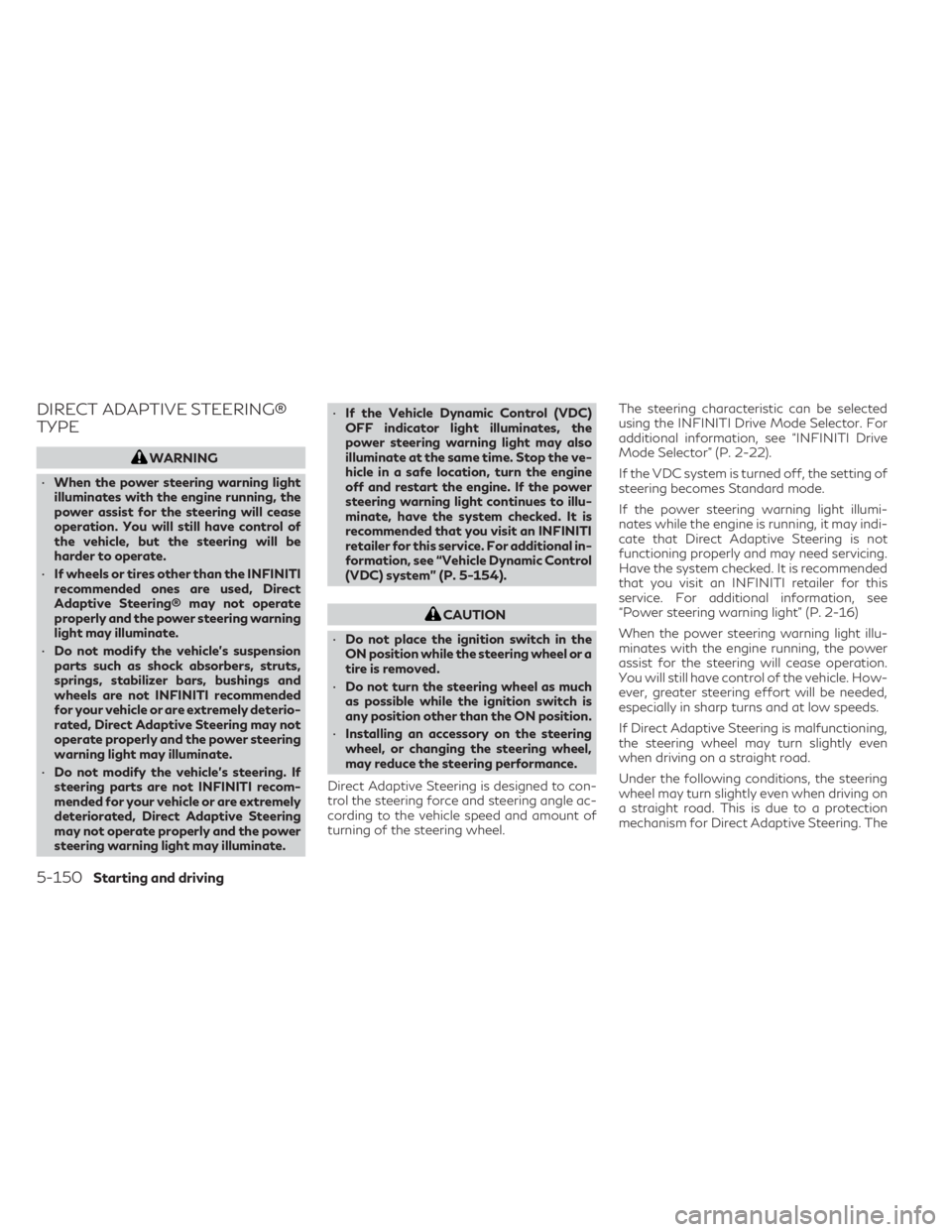
DIRECT ADAPTIVE STEERING®
TYPE
WARNING
• When the power steering warning light
illuminates with the engine running, the
power assist for the steering will cease
operation. You will still have control of
the vehicle, but the steering will be
harder to operate.
• If wheels or tires other than the INFINITI
recommended ones are used, Direct
Adaptive Steering® may not operate
properly and the power steering warning
light may illuminate.
• Do not modify the vehicle’s suspension
parts such as shock absorbers, struts,
springs, stabilizer bars, bushings and
wheels are not INFINITI recommended
for your vehicle or are extremely deterio-
rated, Direct Adaptive Steering may not
operate properly and the power steering
warning light may illuminate.
• Do not modify the vehicle’s steering. If
steering parts are not INFINITI recom-
mended for your vehicle or are extremely
deteriorated, Direct Adaptive Steering
may not operate properly and the power
steering warning light may illuminate. •
If the Vehicle Dynamic Control (VDC)
OFF indicator light illuminates, the
power steering warning light may also
illuminate at the same time. Stop the ve-
hicle in a safe location, turn the engine
off and restart the engine. If the power
steering warning light continues to illu-
minate, have the system checked. It is
recommended that you visit an INFINITI
retailer for this service. For additional in-
formation, see “Vehicle Dynamic Control
(VDC) system” (P. 5-154).
CAUTION
• Do not place the ignition switch in the
ON position while the steering wheel or a
tire is removed.
• Do not turn the steering wheel as much
as possible while the ignition switch is
any position other than the ON position.
• Installing an accessory on the steering
wheel, or changing the steering wheel,
may reduce the steering performance.
Direct Adaptive Steering is designed to con-
trol the steering force and steering angle ac-
cording to the vehicle speed and amount of
turning of the steering wheel. The steering characteristic can be selected
using the INFINITI Drive Mode Selector. For
additional information, see “INFINITI Drive
Mode Selector” (P. 2-22).
If the VDC system is turned off, the setting of
steering becomes Standard mode.
If the power steering warning light illumi-
nates while the engine is running, it may indi-
cate that Direct Adaptive Steering is not
functioning properly and may need servicing.
Have the system checked. It is recommended
that you visit an INFINITI retailer for this
service. For additional information, see
“Power steering warning light” (P. 2-16)
When the power steering warning light illu-
minates with the engine running, the power
assist for the steering will cease operation.
You will still have control of the vehicle. How-
ever, greater steering effort will be needed,
especially in sharp turns and at low speeds.
If Direct Adaptive Steering is malfunctioning,
the steering wheel may turn slightly even
when driving on a straight road.
Under the following conditions, the steering
wheel may turn slightly even when driving on
a straight road. This is due to a protection
mechanism for Direct Adaptive Steering. The
5-150Starting and driving
Page 393 of 542

steering wheel will return to the normal posi-
tion after the protection mechanism is
deactivated.
Condition A:
• When the engine is stalled or likely to bestalled
• When the steering wheel is held in the full lock position or when the front tire touches
an obstruction
• When the battery is discharged
To return the steering wheel to the normal
position, stop the vehicle in a safe location
and stop operating the steering wheel. Then
drive the vehicle for a short period of time.
Condition B:
• When the steering wheel is operated re- peatedly or continuously while parking or
driving at a very low speed. In this case, the
power assist for the steering wheel will be
reduced.
To return the steering wheel to the normal
position, stop the vehicle in a safe location
and wait for a period of time, without oper-
ating the steering wheel, until the tempera-
ture of Direct Adaptive Steering cools down.
Avoid repeated steering wheel operations
that could cause Direct Adaptive Steering to
overheat. When the vehicle is tested on the 2–wheel
dynamometer, the power steering warning
light may illuminate. To turn off the power
steering warning light, stop the vehicle in a
safe location, turn the engine off, restart the
engine, and then drive the vehicle for a period
of time.
The following conditions do not indicate a
malfunction of Direct Adaptive Steering:
• You may notice wider steering play when
the ignition switch is in the OFF or AUTO
ACC position compared to when it is in the
ON position.
• After the engine is started, the steering wheel may turn slightly even when driving a
straight road. To return to the normal posi-
tion, drive the vehicle on a straight road for
a period of time.
• After the engine is started, the steering wheel may move if the steering wheel was
turned to the fully locked position while the
ignition switch was in the OFF position.
• After the vehicle is tested on the 4–wheel dynamometer, the steering wheel may turn
slightly even when driving on a straight
road. To return the steering wheel to the
normal position, drive the vehicle on a
straight road for a period of time. You may hear a noise under the following
conditions. However, this is not a malfunc-
tion.
• When the engine is started or stopped.
• When the steering wheel is turned in the full
lock position.
Starting and driving5-151
Page 396 of 542
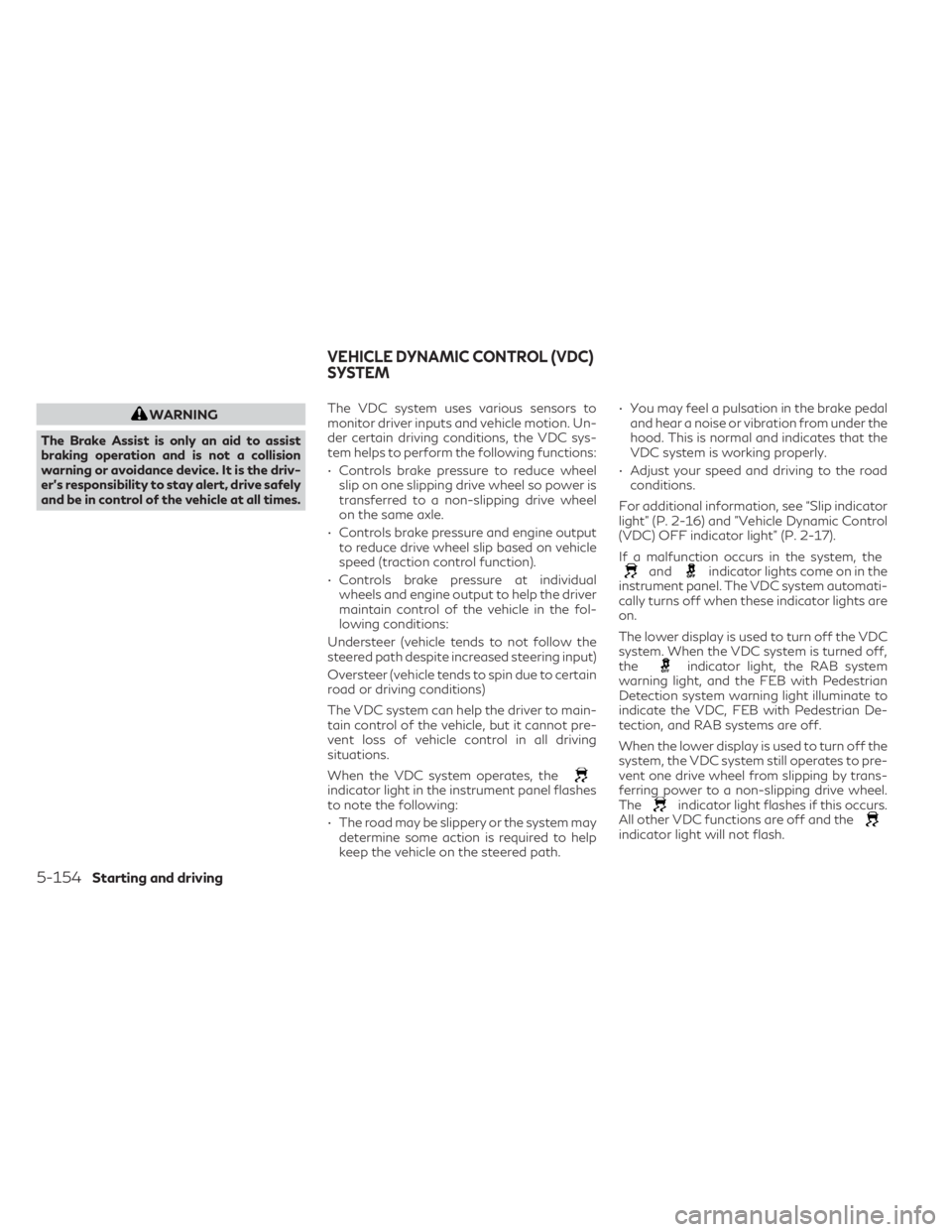
WARNING
The Brake Assist is only an aid to assist
braking operation and is not a collision
warning or avoidance device. It is the driv-
er’s responsibility to stay alert, drive safely
and be in control of the vehicle at all times. The VDC system uses various sensors to
monitor driver inputs and vehicle motion. Un-
der certain driving conditions, the VDC sys-
tem helps to perform the following functions:
• Controls brake pressure to reduce wheel
slip on one slipping drive wheel so power is
transferred to a non-slipping drive wheel
on the same axle.
• Controls brake pressure and engine output to reduce drive wheel slip based on vehicle
speed (traction control function).
• Controls brake pressure at individual wheels and engine output to help the driver
maintain control of the vehicle in the fol-
lowing conditions:
Understeer (vehicle tends to not follow the
steered path despite increased steering input)
Oversteer (vehicle tends to spin due to certain
road or driving conditions)
The VDC system can help the driver to main-
tain control of the vehicle, but it cannot pre-
vent loss of vehicle control in all driving
situations.
When the VDC system operates, the
indicator light in the instrument panel flashes
to note the following:
• The road may be slippery or the system may determine some action is required to help
keep the vehicle on the steered path. • You may feel a pulsation in the brake pedal
and hear a noise or vibration from under the
hood. This is normal and indicates that the
VDC system is working properly.
• Adjust your speed and driving to the road conditions.
For additional information, see “Slip indicator
light” (P. 2-16) and ”Vehicle Dynamic Control
(VDC) OFF indicator light” (P. 2-17).
If a malfunction occurs in the system, the
andindicator lights come on in the
instrument panel. The VDC system automati-
cally turns off when these indicator lights are
on.
The lower display is used to turn off the VDC
system. When the VDC system is turned off,
the
indicator light, the RAB system
warning light, and the FEB with Pedestrian
Detection system warning light illuminate to
indicate the VDC, FEB with Pedestrian De-
tection, and RAB systems are off.
When the lower display is used to turn off the
system, the VDC system still operates to pre-
vent one drive wheel from slipping by trans-
ferring power to a non-slipping drive wheel.
The
indicator light flashes if this occurs.
All other VDC functions are off and the
indicator light will not flash.
VEHICLE DYNAMIC CONTROL (VDC)
SYSTEM
5-154Starting and driving
Page 474 of 542
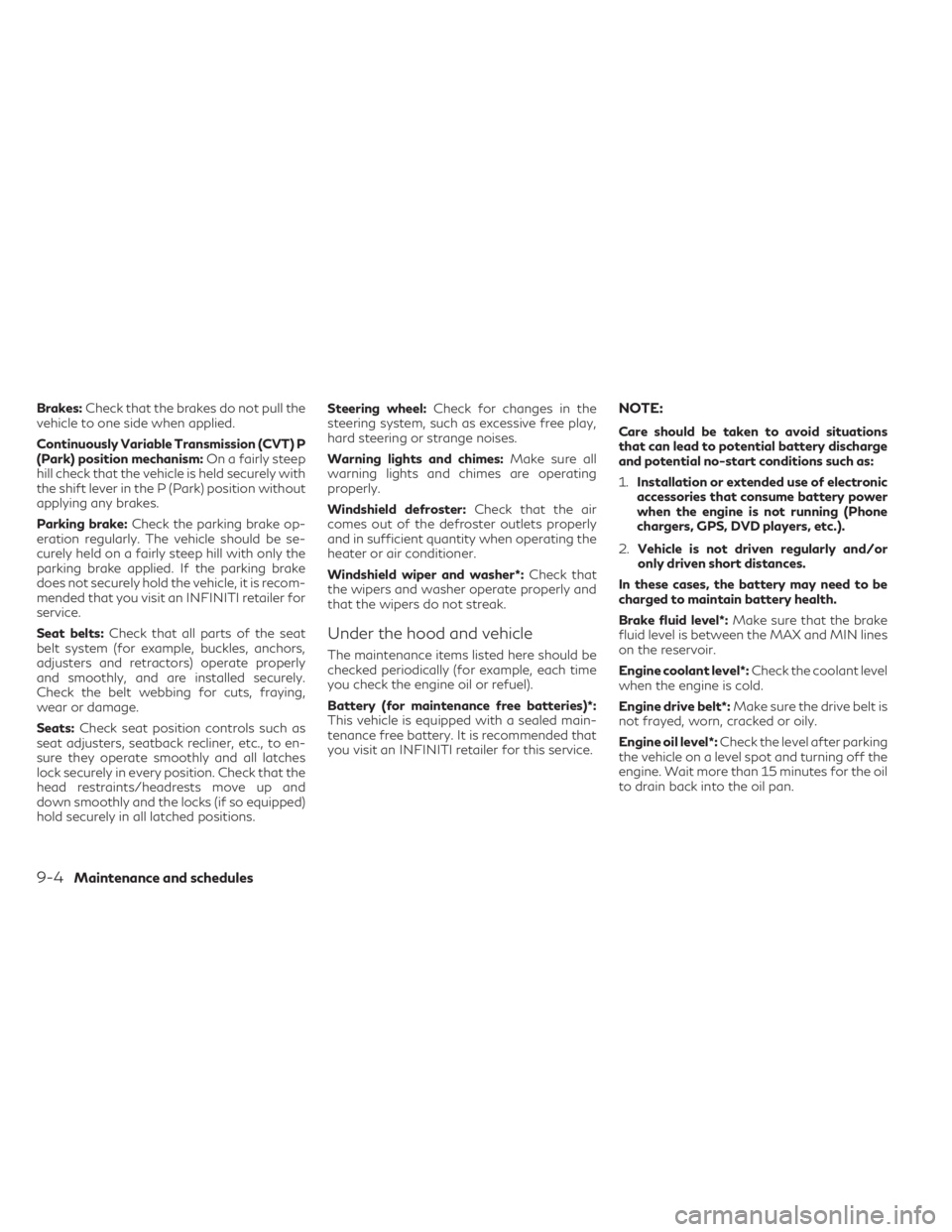
Brakes:Check that the brakes do not pull the
vehicle to one side when applied.
Continuously Variable Transmission (CVT) P
(Park) position mechanism: On a fairly steep
hill check that the vehicle is held securely with
the shift lever in the P (Park) position without
applying any brakes.
Parking brake: Check the parking brake op-
eration regularly. The vehicle should be se-
curely held on a fairly steep hill with only the
parking brake applied. If the parking brake
does not securely hold the vehicle, it is recom-
mended that you visit an INFINITI retailer for
service.
Seat belts: Check that all parts of the seat
belt system (for example, buckles, anchors,
adjusters and retractors) operate properly
and smoothly, and are installed securely.
Check the belt webbing for cuts, fraying,
wear or damage.
Seats: Check seat position controls such as
seat adjusters, seatback recliner, etc., to en-
sure they operate smoothly and all latches
lock securely in every position. Check that the
head restraints/headrests move up and
down smoothly and the locks (if so equipped)
hold securely in all latched positions. Steering wheel:
Check for changes in the
steering system, such as excessive free play,
hard steering or strange noises.
Warning lights and chimes: Make sure all
warning lights and chimes are operating
properly.
Windshield defroster: Check that the air
comes out of the defroster outlets properly
and in sufficient quantity when operating the
heater or air conditioner.
Windshield wiper and washer*: Check that
the wipers and washer operate properly and
that the wipers do not streak.
Under the hood and vehicle
The maintenance items listed here should be
checked periodically (for example, each time
you check the engine oil or refuel).
Battery (for maintenance free batteries)*:
This vehicle is equipped with a sealed main-
tenance free battery. It is recommended that
you visit an INFINITI retailer for this service.
NOTE:
Care should be taken to avoid situations
that can lead to potential battery discharge
and potential no-start conditions such as:
1. Installation or extended use of electronic
accessories that consume battery power
when the engine is not running (Phone
chargers, GPS, DVD players, etc.).
2. Vehicle is not driven regularly and/or
only driven short distances.
In these cases, the battery may need to be
charged to maintain battery health.
Brake fluid level*: Make sure that the brake
fluid level is between the MAX and MIN lines
on the reservoir.
Engine coolant level*: Check the coolant level
when the engine is cold.
Engine drive belt*: Make sure the drive belt is
not frayed, worn, cracked or oily.
Engine oil level*: Check the level after parking
the vehicle on a level spot and turning off the
engine. Wait more than 15 minutes for the oil
to drain back into the oil pan.
9-4Maintenance and schedules
Page 479 of 542
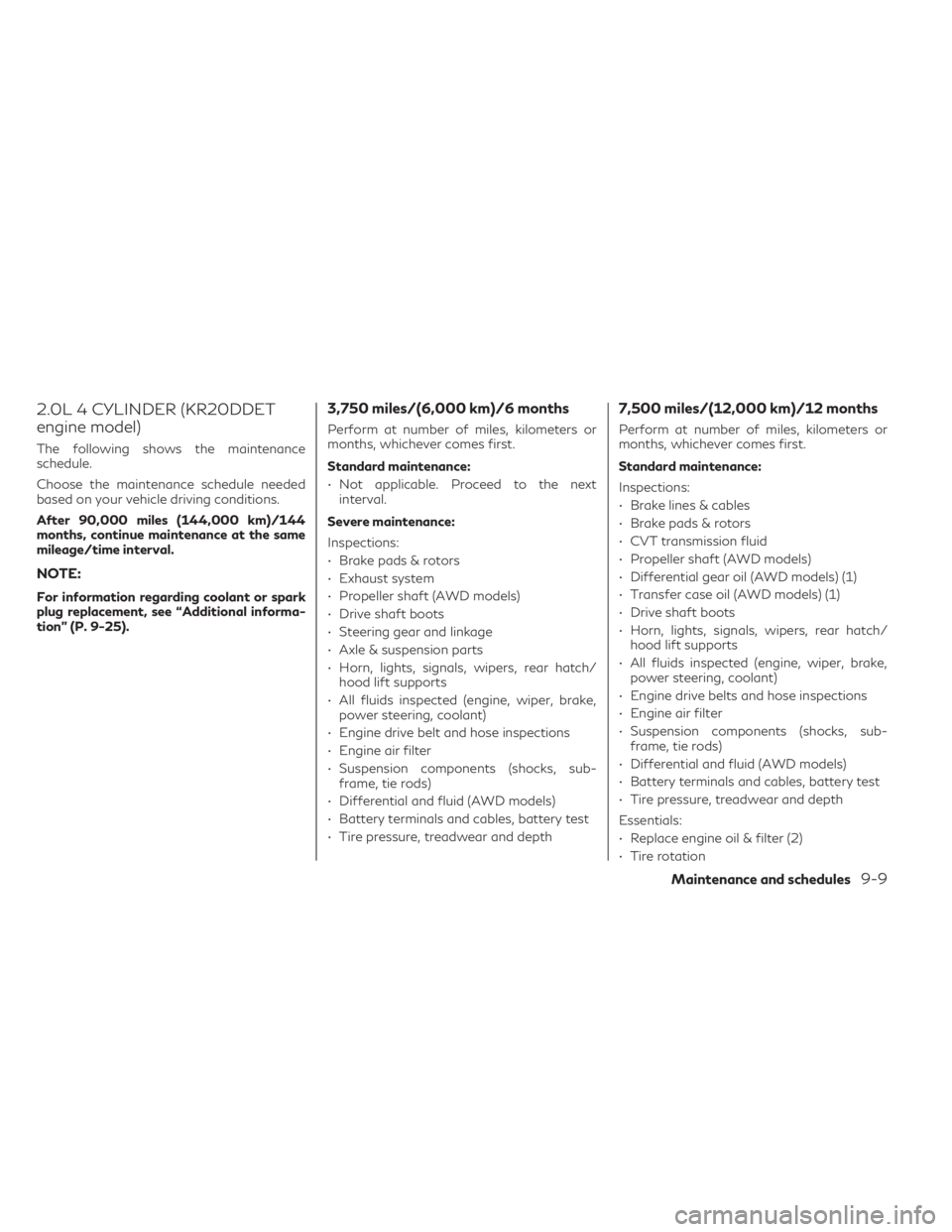
2.0L 4 CYLINDER (KR20DDET
engine model)
The following shows the maintenance
schedule.
Choose the maintenance schedule needed
based on your vehicle driving conditions.
After 90,000 miles (144,000 km)/144
months, continue maintenance at the same
mileage/time interval.
NOTE:
For information regarding coolant or spark
plug replacement, see “Additional informa-
tion” (P. 9-25).
3,750 miles/(6,000 km)/6 months
Perform at number of miles, kilometers or
months, whichever comes first.
Standard maintenance:
• Not applicable. Proceed to the nextinterval.
Severe maintenance:
Inspections:
• Brake pads & rotors
• Exhaust system
• Propeller shaft (AWD models)
• Drive shaft boots
• Steering gear and linkage
• Axle & suspension parts
• Horn, lights, signals, wipers, rear hatch/ hood lift supports
• All fluids inspected (engine, wiper, brake, power steering, coolant)
• Engine drive belt and hose inspections
• Engine air filter
• Suspension components (shocks, sub- frame, tie rods)
• Differential and fluid (AWD models)
• Battery terminals and cables, battery test
• Tire pressure, treadwear and depth
7,500 miles/(12,000 km)/12 months
Perform at number of miles, kilometers or
months, whichever comes first.
Standard maintenance:
Inspections:
• Brake lines & cables
• Brake pads & rotors
• CVT transmission fluid
• Propeller shaft (AWD models)
• Differential gear oil (AWD models) (1)
• Transfer case oil (AWD models) (1)
• Drive shaft boots
• Horn, lights, signals, wipers, rear hatch/ hood lift supports
• All fluids inspected (engine, wiper, brake, power steering, coolant)
• Engine drive belts and hose inspections
• Engine air filter
• Suspension components (shocks, sub- frame, tie rods)
• Differential and fluid (AWD models)
• Battery terminals and cables, battery test
• Tire pressure, treadwear and depth
Essentials:
• Replace engine oil & filter (2)
• Tire rotation
Maintenance and schedules9-9
Page 480 of 542
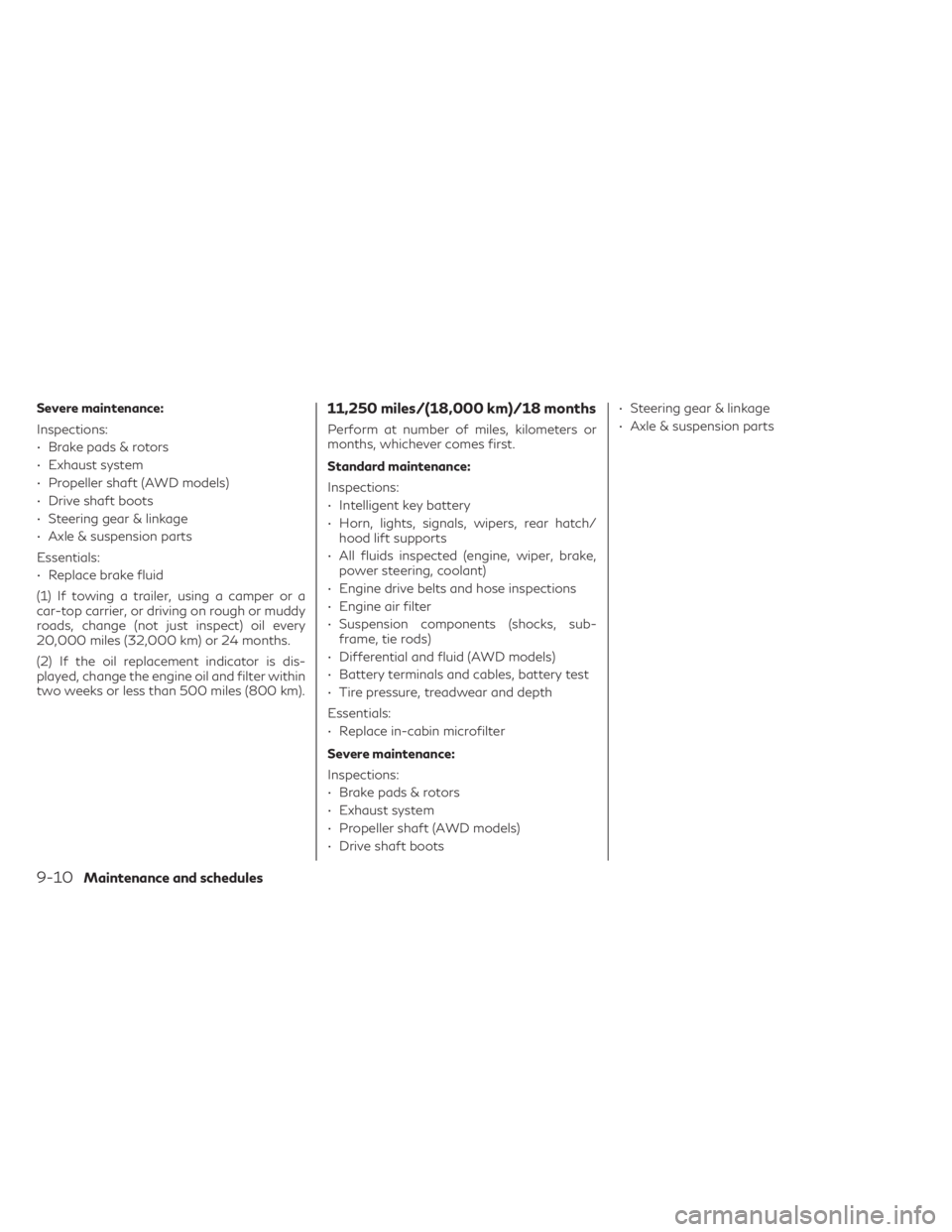
Severe maintenance:
Inspections:
• Brake pads & rotors
• Exhaust system
• Propeller shaft (AWD models)
• Drive shaft boots
• Steering gear & linkage
• Axle & suspension parts
Essentials:
• Replace brake fluid
(1) If towing a trailer, using a camper or a
car-top carrier, or driving on rough or muddy
roads, change (not just inspect) oil every
20,000 miles (32,000 km) or 24 months.
(2) If the oil replacement indicator is dis-
played, change the engine oil and filter within
two weeks or less than 500 miles (800 km).11,250 miles/(18,000 km)/18 months
Perform at number of miles, kilometers or
months, whichever comes first.
Standard maintenance:
Inspections:
• Intelligent key battery
• Horn, lights, signals, wipers, rear hatch/hood lift supports
• All fluids inspected (engine, wiper, brake, power steering, coolant)
• Engine drive belts and hose inspections
• Engine air filter
• Suspension components (shocks, sub- frame, tie rods)
• Differential and fluid (AWD models)
• Battery terminals and cables, battery test
• Tire pressure, treadwear and depth
Essentials:
• Replace in-cabin microfilter
Severe maintenance:
Inspections:
• Brake pads & rotors
• Exhaust system
• Propeller shaft (AWD models)
• Drive shaft boots • Steering gear & linkage
• Axle & suspension parts
9-10Maintenance and schedules
Page 481 of 542
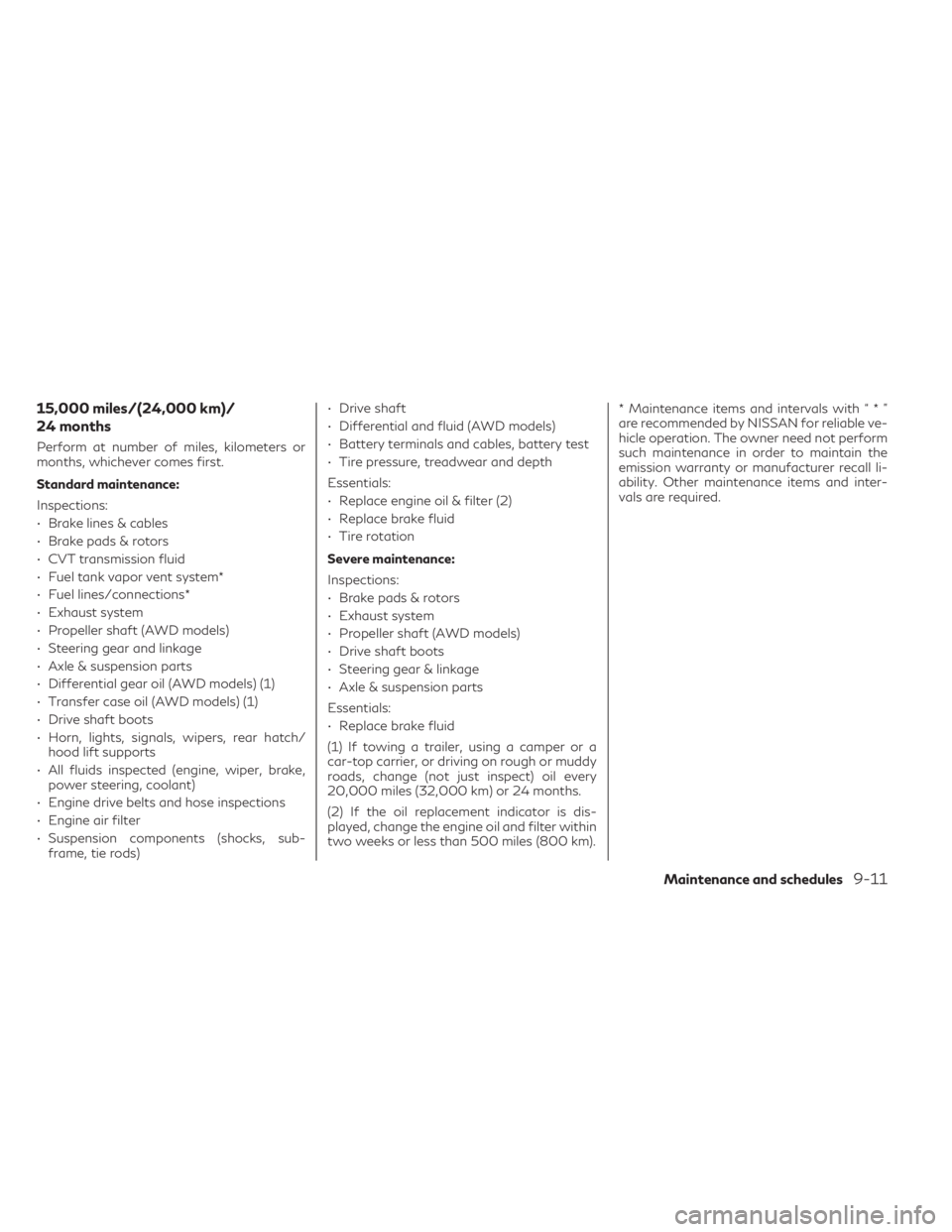
15,000 miles/(24,000 km)/
24 months
Perform at number of miles, kilometers or
months, whichever comes first.
Standard maintenance:
Inspections:
• Brake lines & cables
• Brake pads & rotors
• CVT transmission fluid
• Fuel tank vapor vent system*
• Fuel lines/connections*
• Exhaust system
• Propeller shaft (AWD models)
• Steering gear and linkage
• Axle & suspension parts
• Differential gear oil (AWD models) (1)
• Transfer case oil (AWD models) (1)
• Drive shaft boots
• Horn, lights, signals, wipers, rear hatch/hood lift supports
• All fluids inspected (engine, wiper, brake, power steering, coolant)
• Engine drive belts and hose inspections
• Engine air filter
• Suspension components (shocks, sub- frame, tie rods) • Drive shaft
• Differential and fluid (AWD models)
• Battery terminals and cables, battery test
• Tire pressure, treadwear and depth
Essentials:
• Replace engine oil & filter (2)
• Replace brake fluid
• Tire rotation
Severe maintenance:
Inspections:
• Brake pads & rotors
• Exhaust system
• Propeller shaft (AWD models)
• Drive shaft boots
• Steering gear & linkage
• Axle & suspension parts
Essentials:
• Replace brake fluid
(1) If towing a trailer, using a camper or a
car-top carrier, or driving on rough or muddy
roads, change (not just inspect) oil every
20,000 miles (32,000 km) or 24 months.
(2) If the oil replacement indicator is dis-
played, change the engine oil and filter within
two weeks or less than 500 miles (800 km).
* Maintenance items and intervals with“*”
are recommended by NISSAN for reliable ve-
hicle operation. The owner need not perform
such maintenance in order to maintain the
emission warranty or manufacturer recall li-
ability. Other maintenance items and inter-
vals are required.
Maintenance and schedules9-11
Page 482 of 542
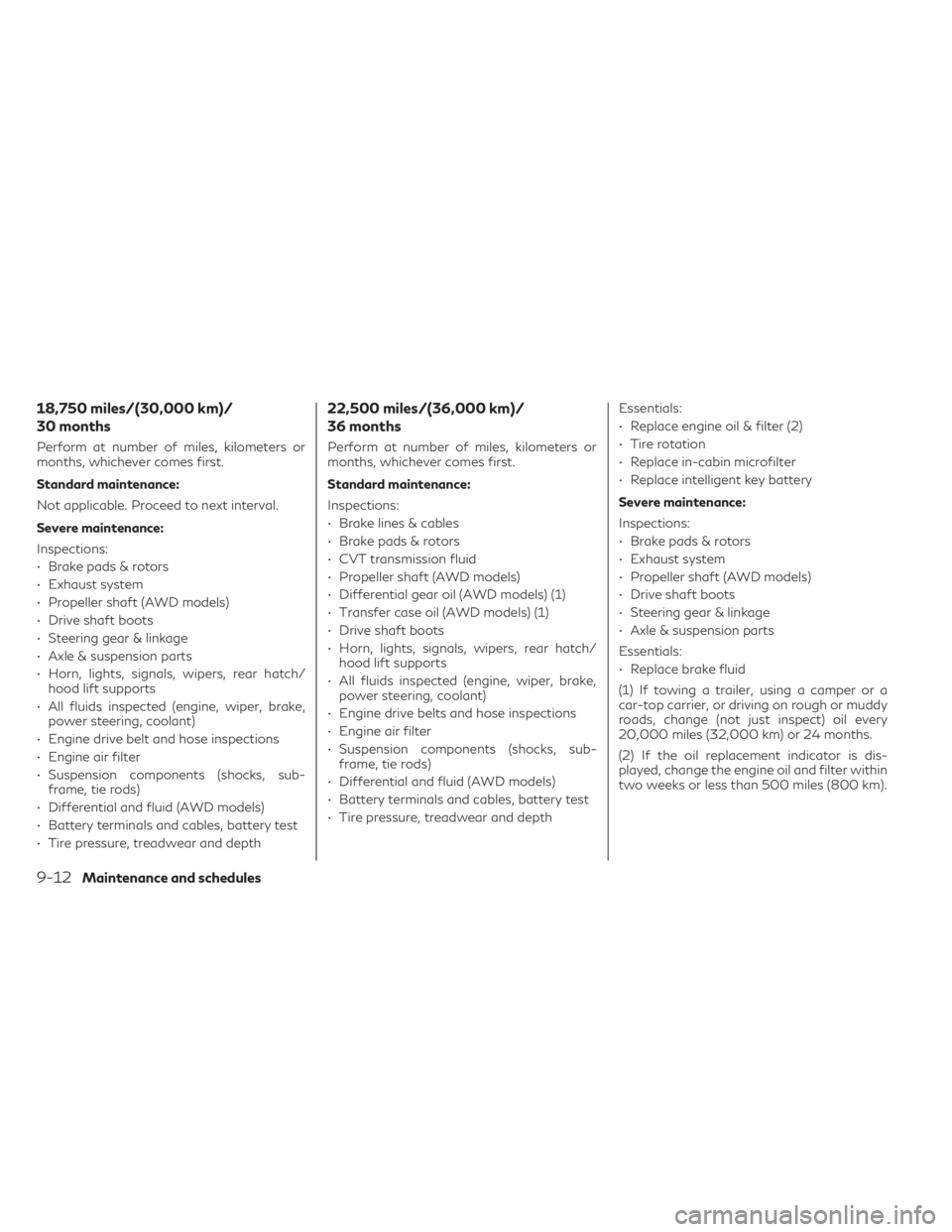
18,750 miles/(30,000 km)/
30 months
Perform at number of miles, kilometers or
months, whichever comes first.
Standard maintenance:
Not applicable. Proceed to next interval.
Severe maintenance:
Inspections:
• Brake pads & rotors
• Exhaust system
• Propeller shaft (AWD models)
• Drive shaft boots
• Steering gear & linkage
• Axle & suspension parts
• Horn, lights, signals, wipers, rear hatch/hood lift supports
• All fluids inspected (engine, wiper, brake, power steering, coolant)
• Engine drive belt and hose inspections
• Engine air filter
• Suspension components (shocks, sub- frame, tie rods)
• Differential and fluid (AWD models)
• Battery terminals and cables, battery test
• Tire pressure, treadwear and depth
22,500 miles/(36,000 km)/
36 months
Perform at number of miles, kilometers or
months, whichever comes first.
Standard maintenance:
Inspections:
• Brake lines & cables
• Brake pads & rotors
• CVT transmission fluid
• Propeller shaft (AWD models)
• Differential gear oil (AWD models) (1)
• Transfer case oil (AWD models) (1)
• Drive shaft boots
• Horn, lights, signals, wipers, rear hatch/ hood lift supports
• All fluids inspected (engine, wiper, brake, power steering, coolant)
• Engine drive belts and hose inspections
• Engine air filter
• Suspension components (shocks, sub- frame, tie rods)
• Differential and fluid (AWD models)
• Battery terminals and cables, battery test
• Tire pressure, treadwear and depth Essentials:
• Replace engine oil & filter (2)
• Tire rotation
• Replace in-cabin microfilter
• Replace intelligent key battery
Severe maintenance:
Inspections:
• Brake pads & rotors
• Exhaust system
• Propeller shaft (AWD models)
• Drive shaft boots
• Steering gear & linkage
• Axle & suspension parts
Essentials:
• Replace brake fluid
(1) If towing a trailer, using a camper or a
car-top carrier, or driving on rough or muddy
roads, change (not just inspect) oil every
20,000 miles (32,000 km) or 24 months.
(2) If the oil replacement indicator is dis-
played, change the engine oil and filter within
two weeks or less than 500 miles (800 km).
9-12Maintenance and schedules
Page 483 of 542
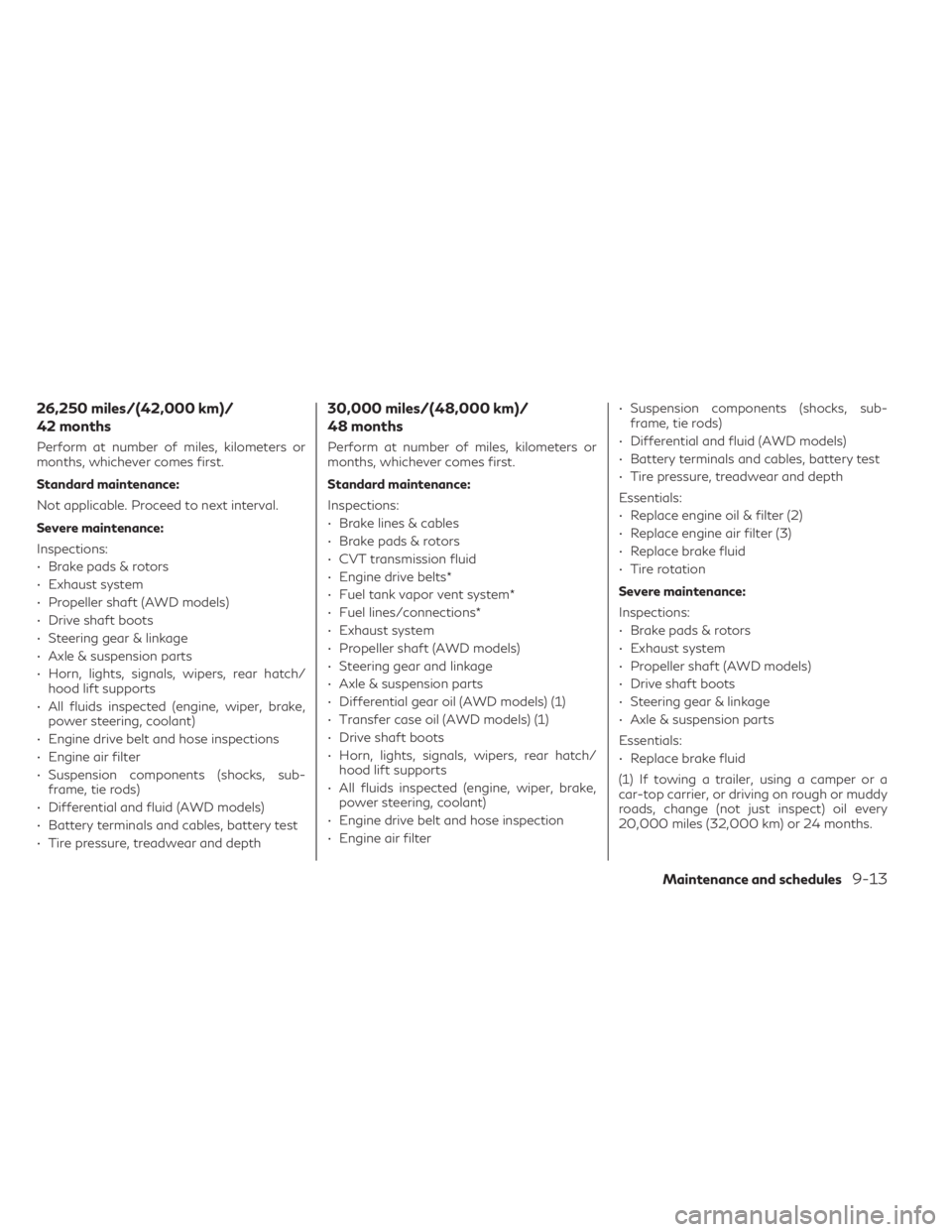
26,250 miles/(42,000 km)/
42 months
Perform at number of miles, kilometers or
months, whichever comes first.
Standard maintenance:
Not applicable. Proceed to next interval.
Severe maintenance:
Inspections:
• Brake pads & rotors
• Exhaust system
• Propeller shaft (AWD models)
• Drive shaft boots
• Steering gear & linkage
• Axle & suspension parts
• Horn, lights, signals, wipers, rear hatch/hood lift supports
• All fluids inspected (engine, wiper, brake, power steering, coolant)
• Engine drive belt and hose inspections
• Engine air filter
• Suspension components (shocks, sub- frame, tie rods)
• Differential and fluid (AWD models)
• Battery terminals and cables, battery test
• Tire pressure, treadwear and depth
30,000 miles/(48,000 km)/
48 months
Perform at number of miles, kilometers or
months, whichever comes first.
Standard maintenance:
Inspections:
• Brake lines & cables
• Brake pads & rotors
• CVT transmission fluid
• Engine drive belts*
• Fuel tank vapor vent system*
• Fuel lines/connections*
• Exhaust system
• Propeller shaft (AWD models)
• Steering gear and linkage
• Axle & suspension parts
• Differential gear oil (AWD models) (1)
• Transfer case oil (AWD models) (1)
• Drive shaft boots
• Horn, lights, signals, wipers, rear hatch/ hood lift supports
• All fluids inspected (engine, wiper, brake, power steering, coolant)
• Engine drive belt and hose inspection
• Engine air filter • Suspension components (shocks, sub-
frame, tie rods)
• Differential and fluid (AWD models)
• Battery terminals and cables, battery test
• Tire pressure, treadwear and depth
Essentials:
• Replace engine oil & filter (2)
• Replace engine air filter (3)
• Replace brake fluid
• Tire rotation
Severe maintenance:
Inspections:
• Brake pads & rotors
• Exhaust system
• Propeller shaft (AWD models)
• Drive shaft boots
• Steering gear & linkage
• Axle & suspension parts
Essentials:
• Replace brake fluid
(1) If towing a trailer, using a camper or a
car-top carrier, or driving on rough or muddy
roads, change (not just inspect) oil every
20,000 miles (32,000 km) or 24 months.
Maintenance and schedules9-13
Page 484 of 542
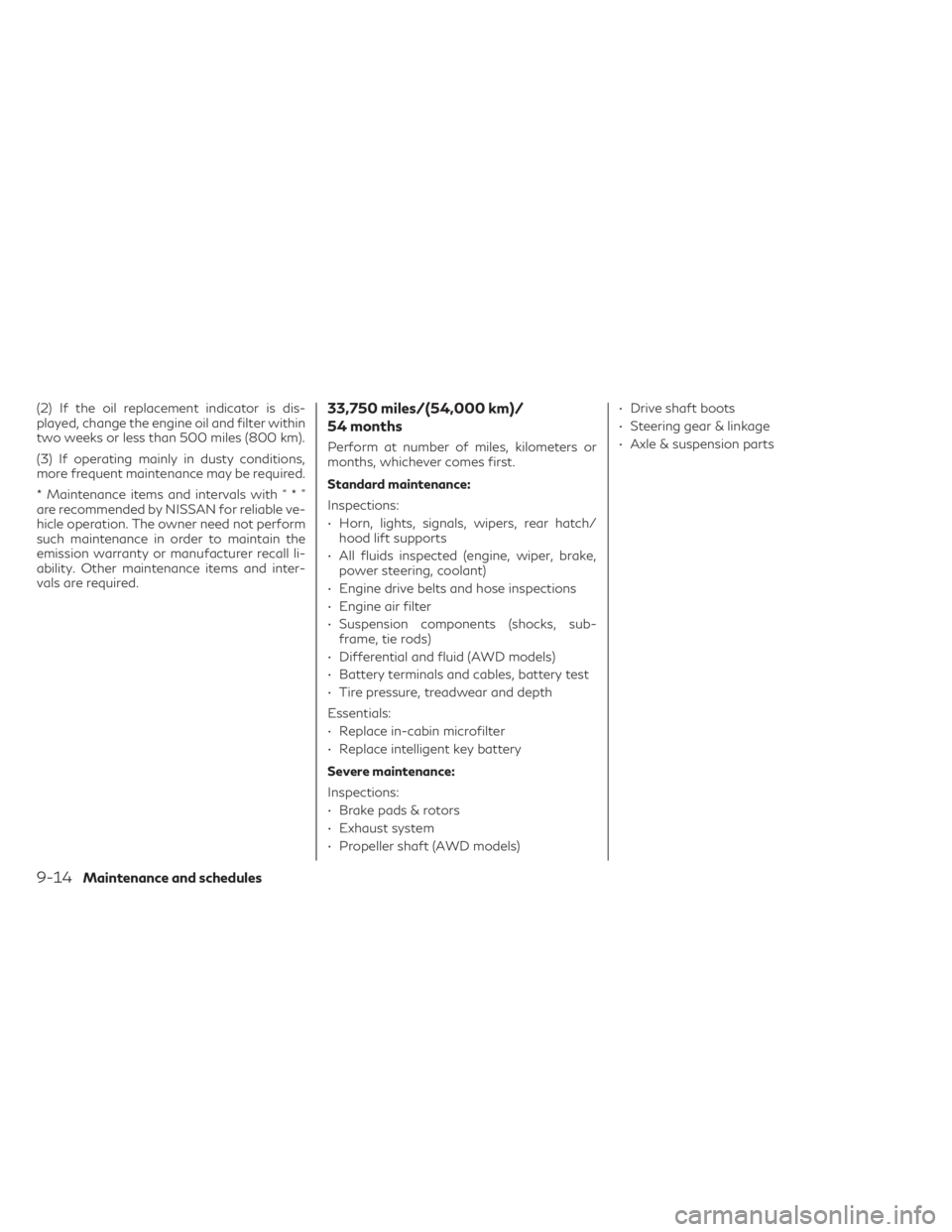
(2) If the oil replacement indicator is dis-
played, change the engine oil and filter within
two weeks or less than 500 miles (800 km).
(3) If operating mainly in dusty conditions,
more frequent maintenance may be required.
* Maintenance items and intervals with“*”
are recommended by NISSAN for reliable ve-
hicle operation. The owner need not perform
such maintenance in order to maintain the
emission warranty or manufacturer recall li-
ability. Other maintenance items and inter-
vals are required.33,750 miles/(54,000 km)/
54 months
Perform at number of miles, kilometers or
months, whichever comes first.
Standard maintenance:
Inspections:
• Horn, lights, signals, wipers, rear hatch/hood lift supports
• All fluids inspected (engine, wiper, brake, power steering, coolant)
• Engine drive belts and hose inspections
• Engine air filter
• Suspension components (shocks, sub- frame, tie rods)
• Differential and fluid (AWD models)
• Battery terminals and cables, battery test
• Tire pressure, treadwear and depth
Essentials:
• Replace in-cabin microfilter
• Replace intelligent key battery
Severe maintenance:
Inspections:
• Brake pads & rotors
• Exhaust system
• Propeller shaft (AWD models) • Drive shaft boots
• Steering gear & linkage
• Axle & suspension parts
9-14Maintenance and schedules